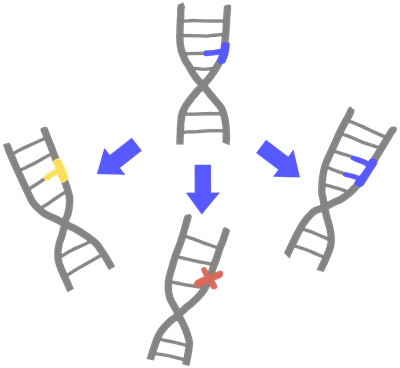
PUMPA - SMART LEARNING
எங்கள் ஆசிரியர்களுடன் 1-ஆன்-1 ஆலோசனை நேரத்தைப் பெறுங்கள். டாப்பர் ஆவதற்கு நாங்கள் பயிற்சி அளிப்போம்
Book Free DemoOrganisms look similar as their body designs are similar. If the body designs are to be similar, the blueprints for the designs should be similar too. Thus, reproduction involves making copies of the blueprints of body design.

Making of DNA copies
As we have seen in Class IX, The Fundamental Unit of Life, the chromosomes present in the nucleus of a cell contains the information for inheritance from parents to the next generation in the form of DNA (Deoxyribo Nucleic Acid) molecules. Thus, DNA contains the blueprint of an organism.

Levelling down from cell to DNA
For the production of proteins, DNA serves as the information source. If information is altered, different proteins are produced that eventually alters the body design. Therefore, the basic event in the process of reproduction is the creation of a DNA copy. Cells employ chemical reactions to produce copies of their DNA.
This results in the production of two similar copies of DNA in the reproducing cell. These DNA molecules are passed on to the two daughter cells. The two daughter cells are identical to each other due to their comparable genetic makeup.

Illustration of cell division
The two daughter cells may be identical or may differ slightly from one another. It all relies on how accurately the DNA copying process has occurred. The copying of DNA does not have to be exact every time, and there may be some variations.
Variations are differences between cells or individuals within a species caused either due to genetic differences or environmental factors.
As a result, the two copies of DNA may resemble the original, but they are not identical. The copies of DNA may have drastic variations from the original, that their survival is challenging. On the other hand, some variations in DNA copies may result in individuals that survive but have slight variations in their characteristics.

Illustration showing variations in DNA due to mutation
Thus, the cells are similar but slightly different from each other. This tendency for variation during reproduction is the basis for evolution, which will be discussed in the next chapter.
The importance of variation:

Genetic variations between the parents and offsprings
In most cases, DNA copying, which is a necessary part of reproduction, is consistent from generation to generation. This aids the offspring's adaptation to a particular type of niche. However, there is a possibility that niches change due to factors beyond the organism's control.
Niche: The role and position of an organism in the ecosystem is known as niche.
Changes may be in the form of increased temperature on earth, varying water levels, meteorite hits, or other ecological imbalances. Any change in the particular niche will undoubtedly affect the consistent population in such circumstances. Species' population could be wiped out because of an abrupt shift in the niche.
There are chances of changes in DNA copying that result in the development of organisms that are better suited to new habitats. If a population of reproducing organisms obtains inheritable changes that enable them to survive in niches, the organisms have a chance of surviving. If the organism does not evolve and the niche changes drastically, the organism would become extinct.
For example, a population of bacteria is growing in temperate water and has established an environmental harmony. Suppose, if the water temperature rises due to global warming, the bacteria will certainly die. However, only those who have developed heat resistance will survive. Variations are thus beneficial to the long-term survival of species.
Reference:
https://commons.wikimedia.org/wiki/File:Eukaryote_DNA-en.svg
https://upload.wikimedia.org/wikipedia/commons/thumb/b/bf/Genetic_variation.png/1024px-Genetic_variation.png
https://innovativegenomics.org/glossary/mutation/
https://www.wannapik.com/vectors/71896
https://upload.wikimedia.org/wikipedia/commons/a/a4/Normal_Cell_Life_Cycle.png